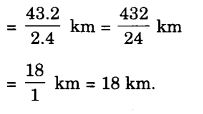GetStudySolution
Getstudysolution is an online educational platform that allows students to access quality educational services and study materials at no cost.
NCERT Solutions for class 7 Maths chapter 2 – Fractions and Decimals
Back Exercise
Exercise 2.1
Question 1.
Solve :
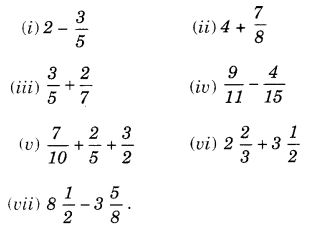
Solution:
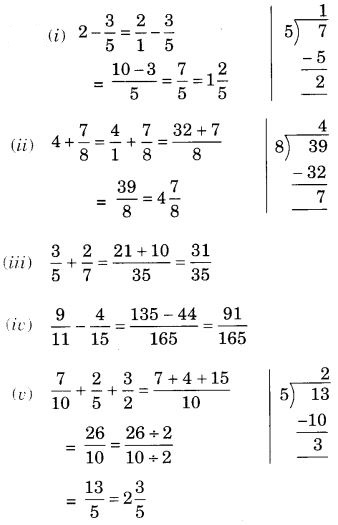
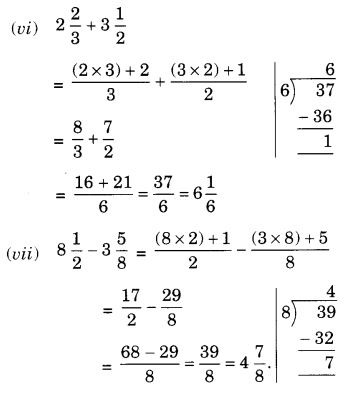
Question 2.
Arrange the following in descending order

Solution:
(i) Converting the given fractions into like fractions, we have
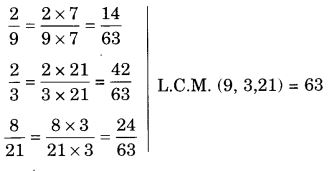
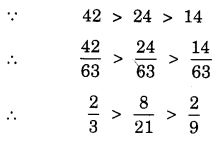
(ii) Converting the given fractions into like fractions, we have
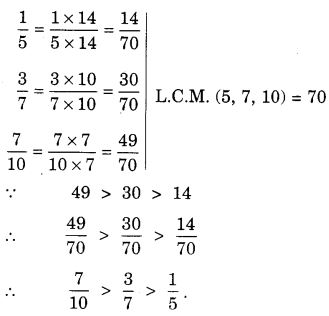
Question 3.
In a “magic square”, the sum of the numbers in each row, in each column and along the diagonals is the same. Is this a magic square?
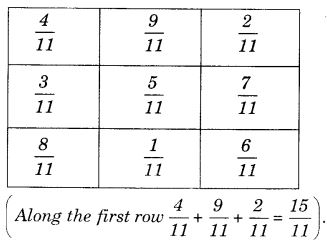
Solution:
Yes ! this is a magic square.
Question 4.
A rectangular sheet of paper is 12
Solution:
Perimeter of the rectangular sheet of paper
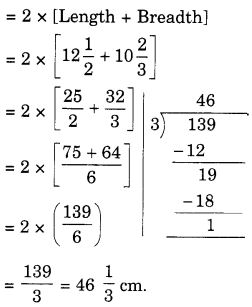
Question 5.
Find the perimeters of (i) A ABE (ii) the rectangle BCDE in this figure. Whose perimeter is greater?
Solution:
(i) Perimeter of ∆ ABE = AB + BE + EA
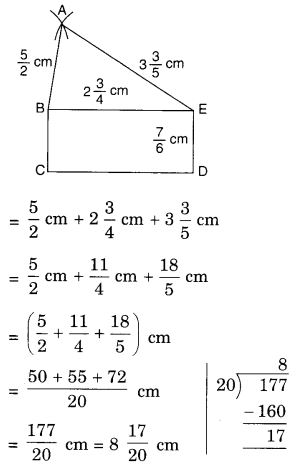
(ii) Perimeter of the rectangle BCDE = BC + CD + DE + EB
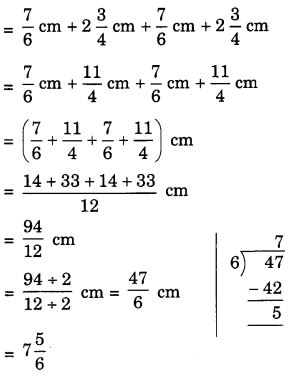
So, the perimeter of A ABE is greater than the perimeter of the rectangle BCDE.
Question 6.
Salil wants to put a picture in a frame. The picture is 7
Solution:
The picture should be trimmed by
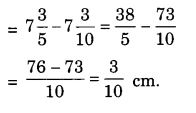
Question 7.
Ritu are
Solution:
Part of the apple ate by Somu
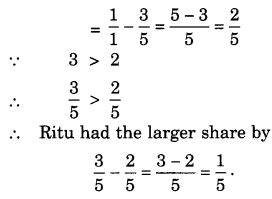
Question 8.
Michael finished colouring a picture in
Solution:
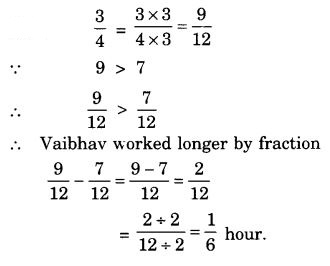
Exercise 2.2
Question 1.
Which of the drawings (a) to (d) show:
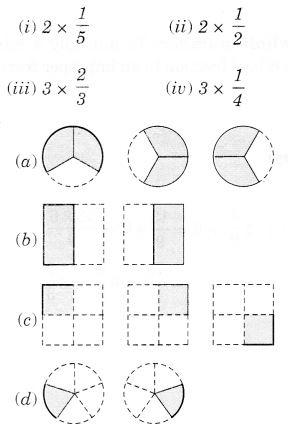
Solution:
(i) (d)
(ii) (b)
(iii) (a)
(iv) (c)
Question 2.
Some pictures (a) to (c) are given below. Tell which of them show:

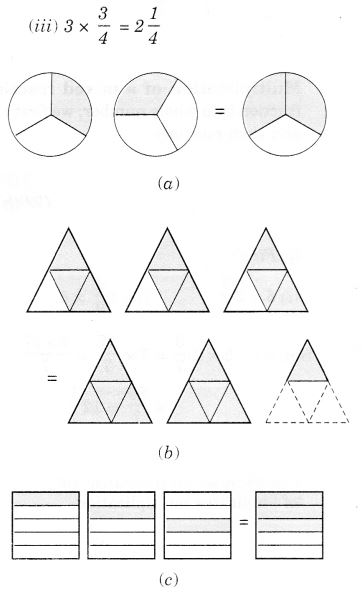
Solution:

Question 3.
Multiply and reduce to lowest form and convert into a mixed fraction:
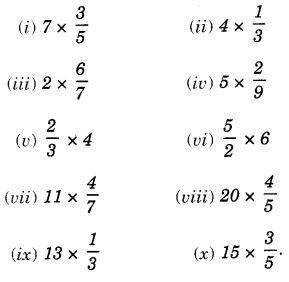
Solution:
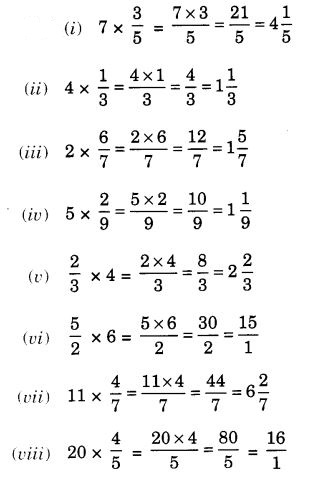
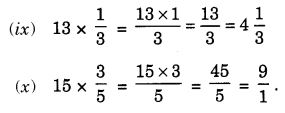
Question 4.
Shade
12 of the circles in box (a)23 of the triangles in box (b)35 of the squares in box (c)
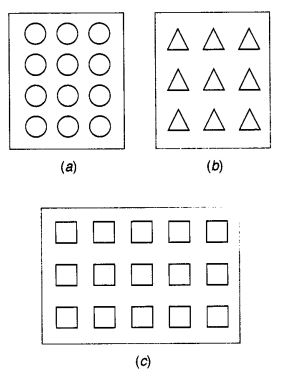
Solution:

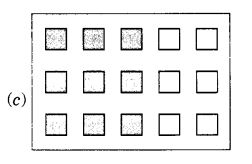
Question 5.
Find:

Solution:
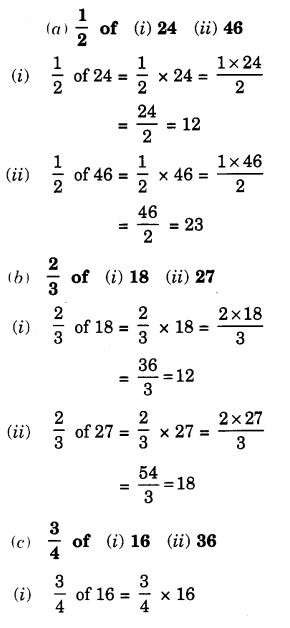
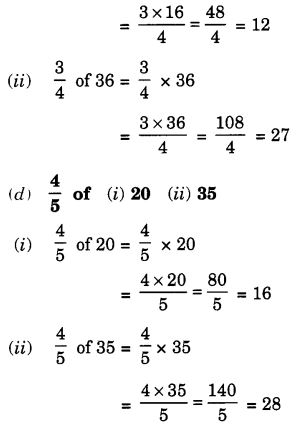
Question 6.
Multiply and express as a mixed fraction:
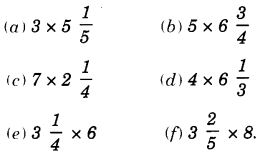
Solution:
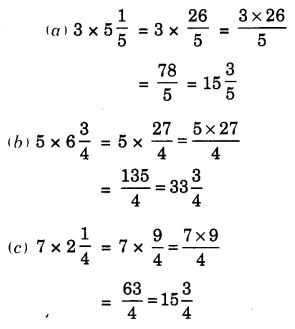
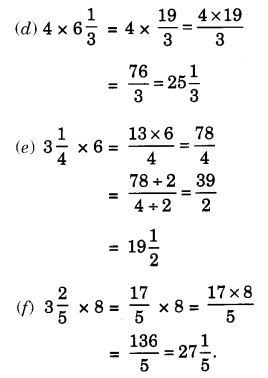
Question 7.
Find
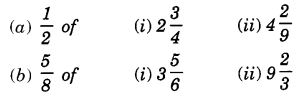
Solution:
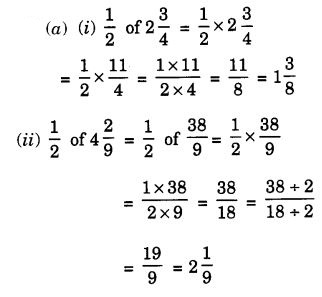
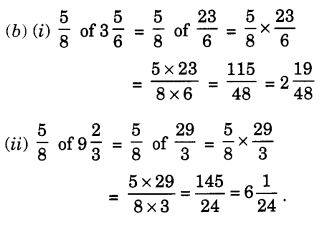
Question 8.
Vidya and Pratap went for a picnic. Their mother gave them a water bottle that contained 5 liters of water. Vidya consumed
(i) How much water did Vidya drink?
(ii) What fraction of the total quantity of water did Pratap drink?
Solution:
(i) Quantity of water drank by Vidya
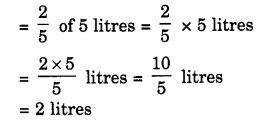
(ii) Quantity of water drank by Pratap
= 5 litres – 2 litres = 3 litres
∴ The fraction of the total quantity of water drank by Pratap
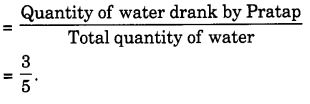
Exercise 2.3
Question 1.
Find:
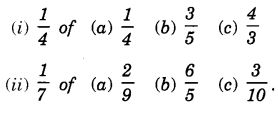
Solution:
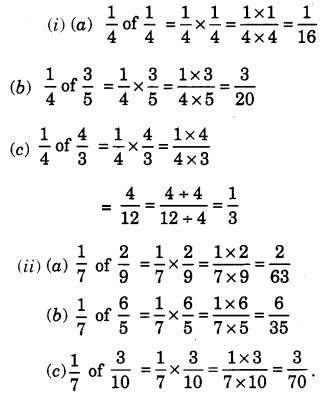
Question 2.
Multiply and reduce to lowest form (if possible):
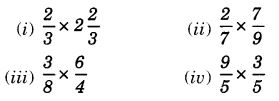

Solution:
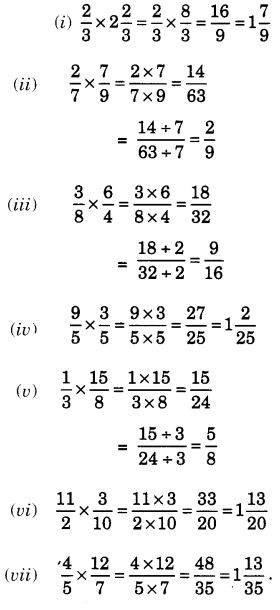
Question 3.
Multiply the following fractions:
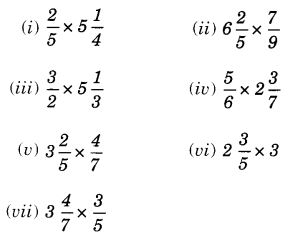
Solution:
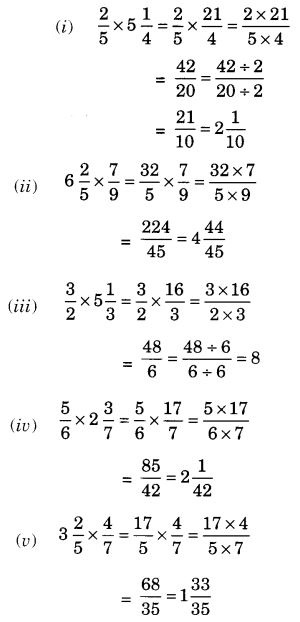
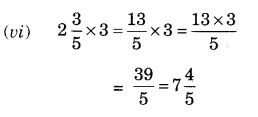
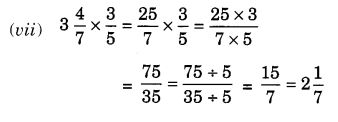
Question 4.
Which is greater:

Solution:
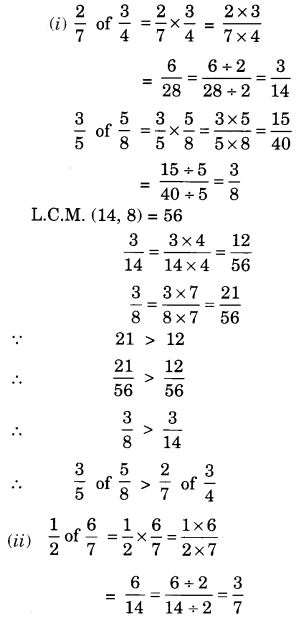

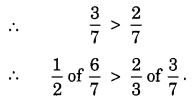
Question 5.
Saili plants 4 saplings, in a row, in her garden. The distance between two adjacent saplings is
Solution:

Let A, B, C and D be the four saplings planted in a row.
Distance between two adjacent saplings =
∴ Distance between the first and the last sapling = AD = 3 × AB
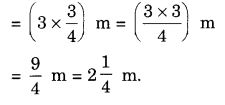
Question 6.
Lipika reads a book for 1
Solution:
Hours in all required by Lipika to read the book
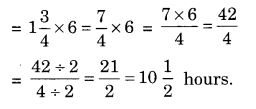
Question 7.
A car runs 16 km using 1 litre of petrol. How much distance will it cover using 2
Solution:
Distance covered by the car using 2
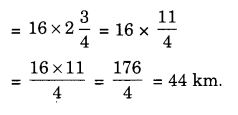
Question 8.
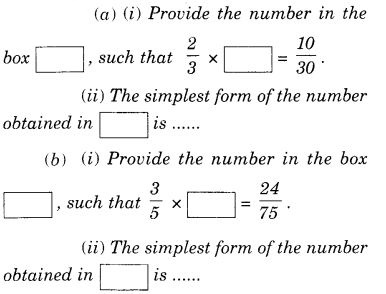
Solution:
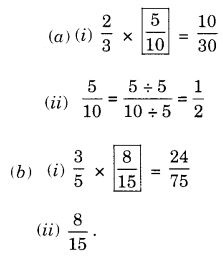
Exercise 2.4
Question 1.
Find:
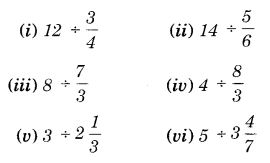
Solution:


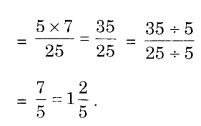
Question 2.
Find the reciprocal of each of the following fractions. Classify the reciprocals as proper fractions, improper fractions and whole numbers.
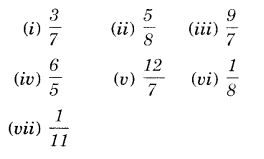
Solution:
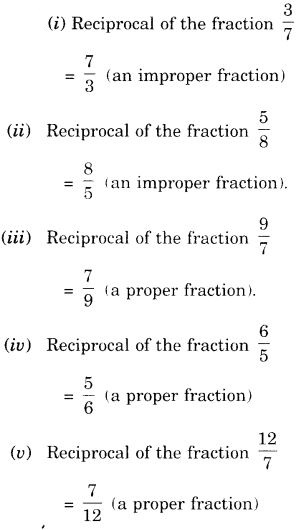

Question 3.
Find:
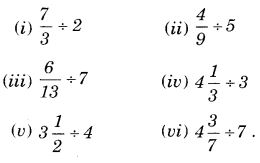
Solution:
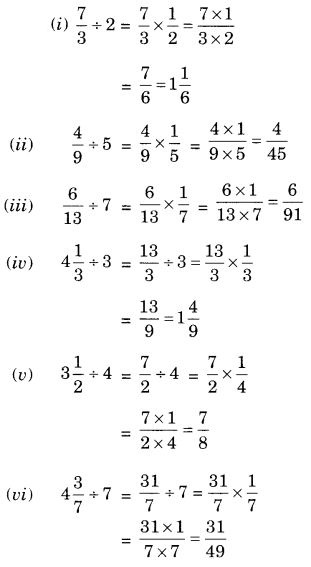
Question 4.
Find:

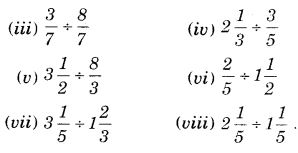
Solution:
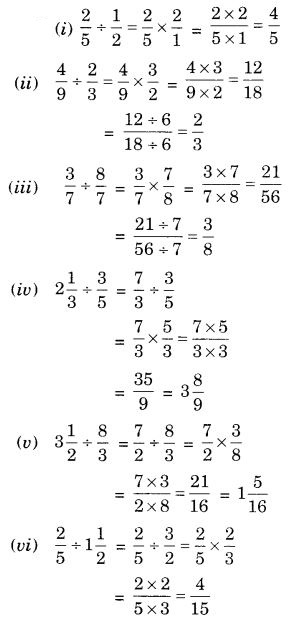
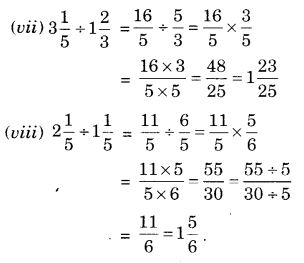
Exercise 2.5
Question 1.
Which is greater?
- 0.5 or 0.05
- 0.7 or 0.5
- 7 or 0.7
- 1.37 or 1.49
- 2.03 or 2.30
- 0.8 or 0.88
Solution:
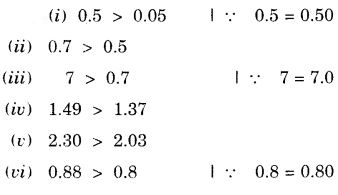
Question 2.
Express as rupees using decimals:
- 7 paise
- 7 rupees 7 paise
- 77 rupees 77 paise
- 50 paise
- 235 paise.
Solution:
- 7 paise = ₹ 0.07
- 7 rupees 7 paise = ₹ 7.07
- 77 rupees 77 paise = ₹ 77.77
- 50 paise – ₹ 0.50
- 235 paise = ₹ 2.35
Question 3.
- Express 5 cm in metre and kilometre
- Express 35 mm in cm, m and km?
Solution:
- 5 cm = 0.05 m = 0.00005 km
- 35 mm = 3.5 cm = 0.035 m = 0.000035 km
Question 4.
Express in kg:
- 200 g
- 3470 g
- 4 kg 8 g
Solution:
- 200 g = 0.200 kg = 0.2 kg
- 3470 g = 3.470 kg
- 4 kg 8 g = 4.008 kg.
Question 5.
Write the following decimal numbers in the expanded form:
- 20.03
- 2.03
- 200.03
- 2.034
Solution:
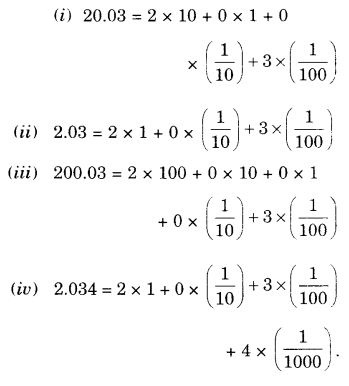
Question 6.
Write the place value of 2 in the following decimal numbers:
- 2.56
- 21.37
- 10.25
- 9.42
- 63.352
Solution:
(i) Place value of 2 in the decimal number 2.56 = 2 × 1 = 2
(ii) Place value of 2 in decimal number 21.37 = 2 × 10 = 20
(iii) Place value of 2 in the decimal number
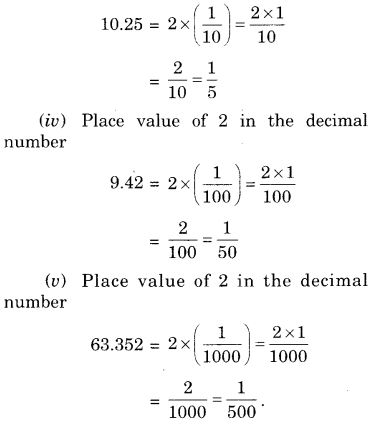
Question 7.
Dinesh went from place A to place t B and from there to place C. A is 7.5 km from B and B is 12.7 km from C. Ayub went from place A to place D and from there to place C. D is 9.3 km from A and C is 11.8 km from D. f Who travelled more and by how much?
Solution:
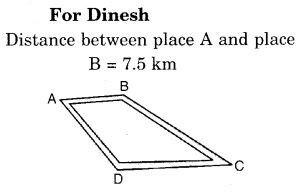
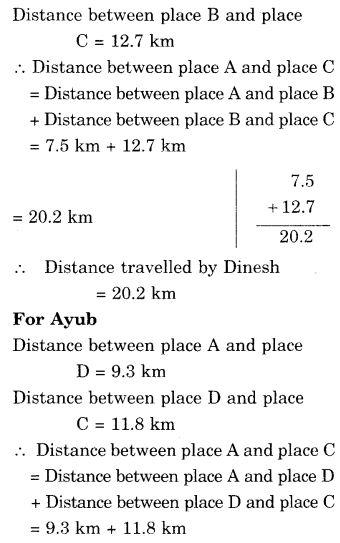
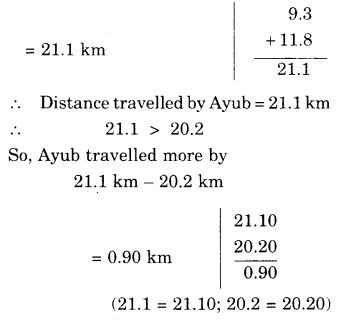
Question 8.
Shyama bought 5 kg 300 g apples and 3 kg 250 g mangoes. Sarala bought 4 kg 800 g oranges and 4 kg 150 g bananas. Who bought more fruits?
Solution:
For Shyama
Apples bought = 5 kg 300 g = 5.300 kg
Mangoes bought = 3 kg 250 g = 3.250 kg
∴ Fruits bought = Apples bought
+ Mangoes bought = 5.300 kg + 3.250 kg
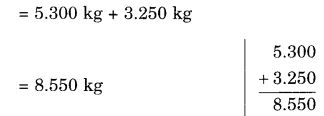
For Sarala
Oranges bought = 4 kg 800 g = 4.800 kg
Bananas bought = 4 kg 150 g = 4.150 kg
∴ Fruits bought = Oranges bought
+ Bananas bought
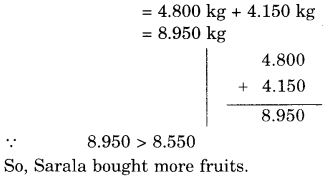
Question 9.
How much less is 28 km than 42.6 km?
Solution:

So, 28 km is less than 42.6 km by 14.6 km.
Exercise 2.6
Question 1.
Find:
- 0.2 × 6
- 8 × 4.6
- 2.71 × 5
- 20.1 × 4
- 0.05 × 7
- 211.02 × 4
- 2 × 0.86
Solution:
- 0.2 × 6 = 1.2
- 8 × 4.6 = : 36.8
- 2.71 × 5 = 13.55
- 20.1 × 4 = 80.4
- 0.05 × 7 = 0.35
- 211.02 × 4 = 844.08
- 2 × 0.86 = 1.72
Question 2.
Find the area of rectangle whose length is 5.7 cm and breadth is 3 cm.
Solution:
Length of the rectangle = 5.7 cm
Breadth of the rectangle = 3 cm
∴ Area of the rectangle
= Length × Breadth
= 5.7 × 3 = 17.1 cm2
Question 3.
Find:
- 1.3 × 10
- 36.8 × 10
- 153.7 × 10
- 168.07 × 10
- 31.1 × 100
- 156.1 × 100
- 3.62 × 100
- 43.07 × 100
- 0.5 × 10
- 0.08 × 10
- 0.9 × 100
- 0.03 × 1000
Solution:
- 1.3 × 10 = 13.0
- 36.8 × 10 = 368.0
- 153.7 × 10 = 1537.0
- 168.07 × 10 = 1680.70
- 31.1 × 100 = = 3110.0
- 156.1 × 100 = 15610.0
- 3.62 × 100 = = 362.00
- 43.07 × 100 = 4307.00
- 0.5 × 10 = 5 .0
- 0.08 × 10 = 0.80
- 0.9 × 100 = 90.0
- 0.03 × 1000 = 30.0.
Question 4.
A two-wheeler covers a distance of 55.3 km in one litre of petrol. How much distance will it cover in 10 litres of petrol?
Solution:
Distance covered in one liter of petrol = 55.3 km
Distance covered in 10 litres of petrol = (55.3 × 10) km = 553 km
Question 5.
Find:
- 2.5 × 0.3
- 0.1 × 51.7
- 0.2 × 316.8
- 1.3 × 3.1
- 0.5 × 0.05
- 11.2 × 0.15
- 1.07 × 0.02
- 10.05 × 1.05
- 101.01 × 0.01
- 100.01 × 1.1
Solution:
- 2.5 × 0.3 = 0.75
- 0.1 × 51.7 = 5 .17
- 0.2 × 316.8 = 63.36
- 1.3 × 3.1 = 4.03
- 0.5 × 0.05 = 0 .025
- 11.2 × 0.15 = 1.680
- 1.07 × 0.02 = 0.0214
- 10.05 × 1.05 = 10.5525
- 101.01 × 0.01 = 1.0101
- 100.01 × 1.1 = 110.011
Exercise 2.7
Question 1.
Find:
- 0.4 ÷ 2
- 0.35 ÷ 5
- 2.48 ÷ 4
- 65.4 ÷ 6
- 651.2 ÷ 4
- 114.49 ÷ 7
- 3.96 ÷ 4
- 0.80 ÷ 5
Solution:
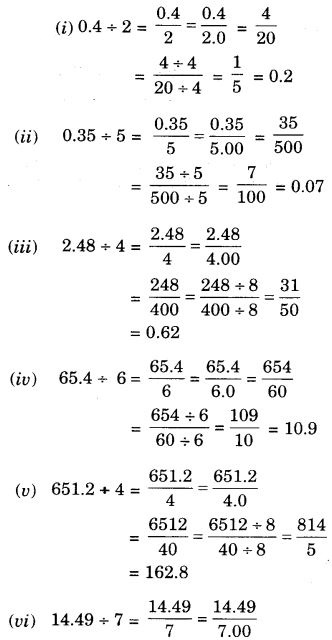
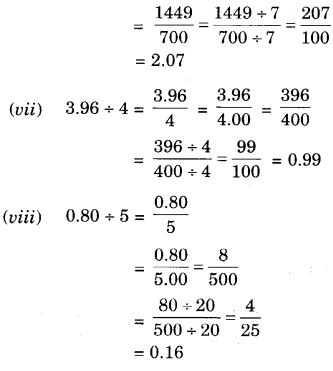
Question 2.
Find:
- 4.8 ÷ 10
- 52.5 ÷ 10
- 0.7 ÷ 10
- 33.1 ÷ 10
- 272.23 ÷ 1o
- 0.56 ÷ 10
- 3.97 ÷ 10
Solution:
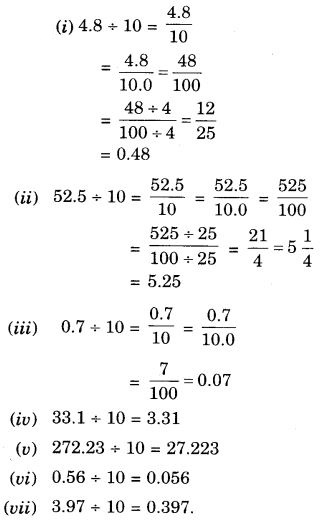
Question 3.
Find:
- 2.7 ÷ 100
- 0.3 ÷ 100
- 0.78 ÷ 100
- 432.6 ÷ 100
- 23.6 ÷ 100
- 98.53 ÷ 100
Solution:
- 2.7 ÷ 100 = 0.027
- 0.3 ÷ 100 = 0.003
- 0.78 ÷ 100 = 0.0078
- 432.6 ÷ 100 = 4.326
- 23.6 ÷ 100 = 0.236
- 98.53 ÷ 100 = 0.9853.
Question 4.
Find:
- 7.9 ÷ 1000
- 26.3 ÷ 2000
- 38.53 ÷ 1000
- 128.9 ÷ 2000
- 0.5 ÷ 2000
Solution:
- 7.9 ÷ 1000 = 0.0079
- 26.3 ÷ 1000 = 0.0263
- 38.53 ÷ 1000 = 0.03853
- 128.9 ÷ 1000 = 0.1289
- 0.5 ÷ 1000 = 0.0005
Question 5.
Find:
- 7 ÷ 3.5
- 36 ÷ 0.2
- 3.25 ÷ 0.5
- 30.94 ÷ 0.7
- 0.5 ÷ 0.25
- 7.75 ÷ 0.25
- 76.5 ÷ 0.15
- 37.8 ÷ 1.4
- 2.73 ÷ 1.3
Solution:
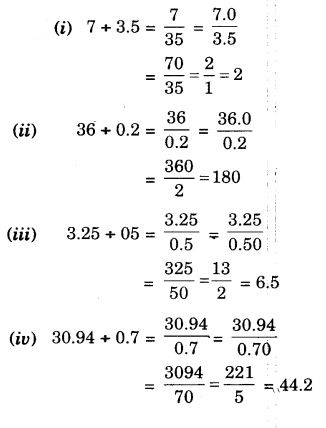
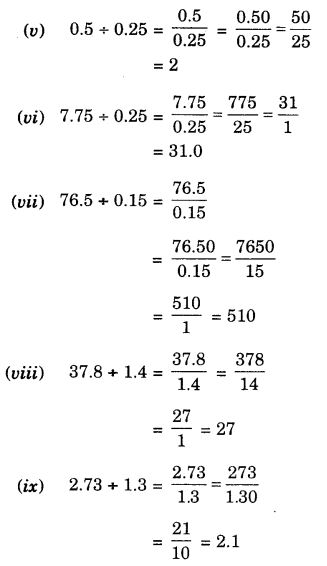
Question 6.
A vehicle covers a distance of 43.2 km in 2.4 litres of petrol. How much distance will it cover in one litre of petrol?
Solution:
∵ Distance covered in 2.4 litres of petrol = 43.2 km
∴ Distance travelled in 1 litre of petrol = 43.2 ÷ 2.4
